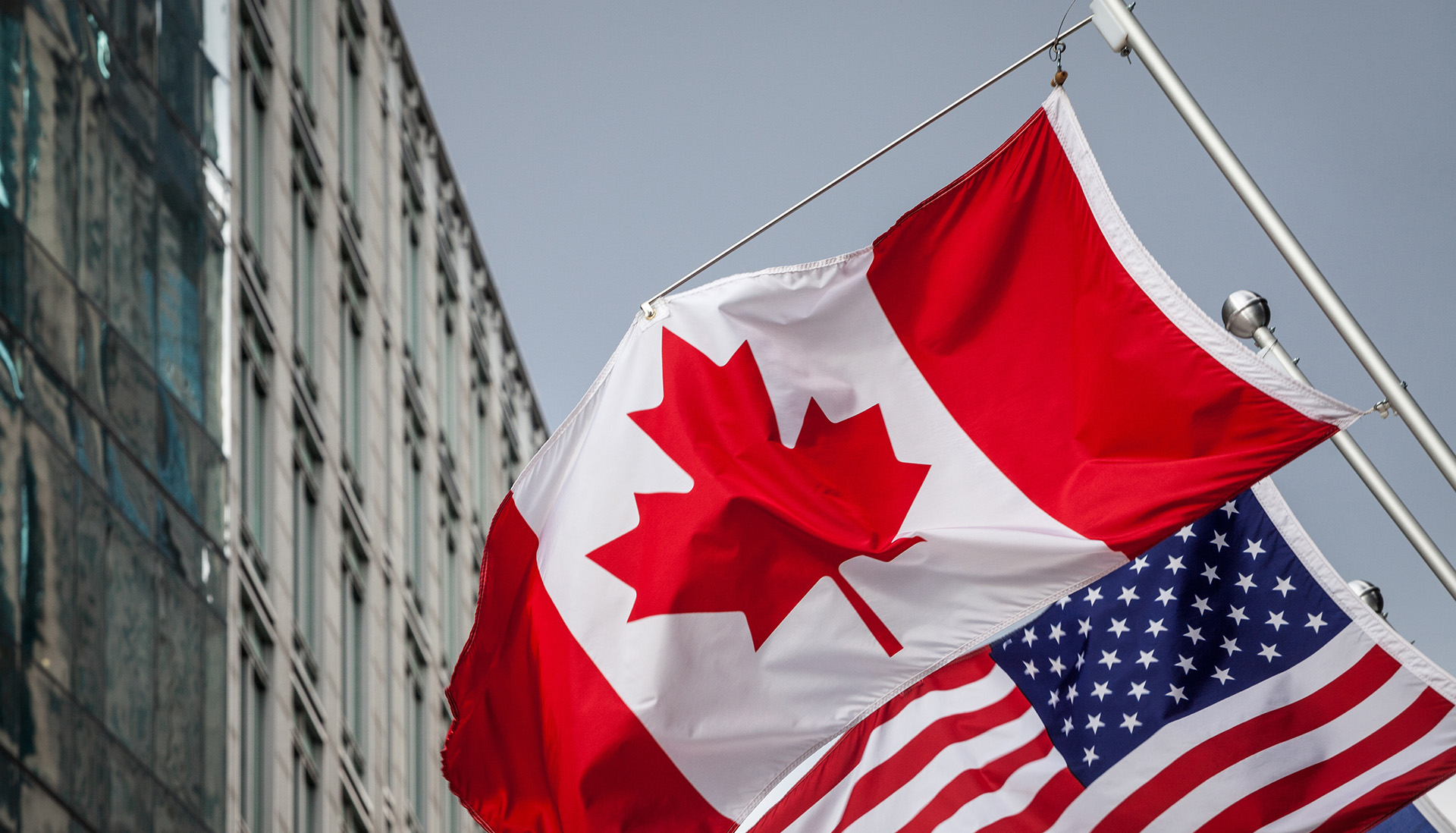We would like to recognize Pasha Ameli, Managing Director of Ankura for their contribution to this article.
Navigating construction project turbulence
Executive summary
The construction industry is facing renewed volatility following the announcement of sweeping U.S. tariffs on Canadian imports and possible retaliatory measures by Canada. With a temporary 30-day hold on these tariffs, the industry has a narrow window to prepare for potential economic disruptions as a result of the tariffs. The recent potential trade war is another reason to revisit important legal strategies that remain relevant for navigating any construction project turbulence.
This article emphasizes the critical need for resilience, diplomacy, and strategic legal foresight to navigate economic shifts. Legal strategies include contract and bid reviews focusing on compensation models and continually reassessing scope of work, change-in-law clauses, detailed force majeure provisions, and risk-sharing mechanisms. Equally important is the role of proactive stakeholder communication, flexible supply chain management, and leveraging data and technology to mitigate risks.
Regardless of the outcome of the current trade negotiations between the U.S. and Canada, the industry must continue to adopt long-term strategies to manage perpetual volatility, emphasizing collaboration, adaptability, and innovative problem-solving.
Roadmap:
- Introduction: Overview of the U.S.-Canada potential countervailing tariffs and the implications for the construction industry.
- Practical legal considerations: Key legal strategies for mitigating project turbulence.
- Diplomacy and de-escalation: The importance of collaborative approaches among stakeholders to manage conflicts and maintain project continuity.
- Conclusion: Reaffirming the need for proactive communication, flexibility, and innovation to thrive amid ongoing economic volatility.
Introduction
On February 1, 2025, the President of the United States announced sweeping tariffs on Canadian imports into the United States, marking a significant moment in the socio-political relationship between the two nations. These tariffs, which were to take effect on February 4, 2025, proposed a 25% levy on most Canadian products and a 10% tariff on energy or energy resources, including Canadian crude oil.[1] In response to the tariffs imposed by the United States, the Canadian government (and several of its Provinces, including Ontario announced retaliatory measures, imposing countervailing tariffs on approximately $155 billion worth of U.S. goods into Canada.
In the late afternoon of February 3, 2025, the U.S. and Canadian governments announced a 30-day pause on imposing any tariffs, providing both governments with time for further “negotiations.” While we cannot predict the full impact of these latest threatened tariffs[2] (if they are in fact levied) on the respective economies of Canada and the U.S., there will certainly be a profound impact on various segments of the economy, including the construction industry. The construction industry is no stranger to uncertainty, volatility and price fluctuations on account of unprecedented and unforeseen events.[3] We need not look further than the lingering effects of the COVID-19 Pandemic since 2020 to understand how the construction industry is impacted by economic fluctuations.
With approximately 30% of Canada’s construction materials sourced from the U.S., including but not limited to steel and iron, and the U.S. similarly dependent on Canada for construction materials, including lumber and aluminum, the tariffs (if imposed) are expected to cause sharp increases in project costs and potential supply chain disruptions. The construction sector, which accounts for 7.5% of Canada’s GDP and 4.5% of the U.S. GDP, now faces the challenge of navigating new economic hurdles as a result of the threatened tariffs. While there will undoubtedly be sentiments of fear and anxiety among all stakeholders in the construction pyramid in respect of proposed tariffs; the reality is that conflict, volatility and political tensions will always be present in the construction industry. As exemplified during the COVID-19 Pandemic, principles of resiliency must prevail and construction stakeholders ought to pause to dissect and navigate these dynamic and delicate times by maintaining diplomacy and implementing de-escalation while leveraging, among other things, collaborative risk sharing, proactive monitoring and data to overcome or at least minimize any impacts caused by the imposition of tariffs.
Irrespective of how the next 30 days unfold, the below content will remain relevant and applicable given that volatility on construction projects remains constant. History tends to repeat itself, such that we will undoubtedly see other forces and pressures in other manifestations impacting the construction industry by driving up material costs, disrupting supply chains, compressing profit margins, altering competitiveness, and potentially adversely affecting the job market.
In response to the tariffs imposed by the United States, as discussed below the Canadian Federal Government and various Provincial Governments proposed numerous measures aimed at protecting Canadian trade.
Canadian Federal Government
The Canadian Federal Government proposed the following measures:
- implementing tariffs on $30 billion worth of U.S. products commencing on February 4, 2025, including everyday commodities such as appliances, cosmetics, orange juice, wine, spirits and beer; and
- planning to impose additional tariffs on $125 billion worth of U.S. products, subject to a 21-day public comment period. The list of additional goods includes passenger vehicles, trucks, steel, aluminum and aerospace products.
Provincial Governments
A number of Provincial Governments introduced additional retaliatory measures. For example in Ontario, the Ontario Provincial Government proposed the following measures:
- barring U.S.-based businesses from participating in provincial procurements, including $200 billion worth of contracts with respect to “Build Ontario” – the Province’s capital infrastructure plan;
- cancelling the Province’s contract with Starlink, a U.S. based internet service provider which aims to provide internet service to northern communities; and
- banning the sale of U.S. liquor, wine and spirits at all Liquor Control Board of Ontario (“LCBO”) locations.
Practical legal considerations
Not surprisingly, there is some overlap with respect to the legal measures that were tabled, recommended and implemented to mitigate the impacts of COVID-19 on construction projects and those measures recommended to mitigate the impact of the latest round of competing U.S./Canadian tariffs. We do not intend to provide an exhaustive list of legal measures that stakeholders ought to consider, but instead some key themes to consider in the context of the recent introduction of tariffs, with the recommendation to seek out professional advisors, as every case is unique with different interests, intentions, risk profiles and tolerances on different projects.
Review your bids and contracts thoroughly
The ongoing trade tensions and tariffs between Canada and the US highlight the importance of choosing the right compensation model for construction contracts and drafting agreements appropriately. By way of example, the contract compensation type (all things being equal, such as no express entitlements to change orders in respect of changes in law or changes in tax, including tariffs, no allowance clauses or contingency account, etc.) — whether Cost-Plus, Time & Materials (T&M), Lump Sum/Fixed Price, or Guaranteed Maximum Price—can have a significant impact on how a project handles cost changes, like unexpected tariffs. When external factors change, such as new taxes or tariffs, the contract compensation model selected can make a difference in managing the financial risks and outcomes, especially during uncertain economic times.
Some contracts may already contain provisions relating to tariffs and duties. For example, in Canada, the CCDC 2 Stipulated Price Contract contains language at GC 10.1 related to changes in taxes and duties, which arguably allows contractors to seek price adjustments if tariffs (which are a form of duties) lead to increased costs.
Change(s) in law/tax: The inclusion of an express provision governing any unforeseen change in laws/tax, specifically and expressly contemplating tariffs, may protect stakeholders from price increases resulting from tariffs. A robust change in law/tax provision (beyond standard form) can allow for adjustments to the contract price and time in the event that any change in law or regulation is enacted and that change directly impacts the cost or time required to perform the contractual scope of work.[4]
Force majeure: After the COVID-19 Pandemic, construction stakeholders are no strangers to hearing the phrase “force majeure event,” and the need to define and enumerate such events accordingly in contracts. While some may argue that many force majeure clauses already capture any impacts as a result of tariffs (i.e. an act of government), drafting a robust force majeure provision, with express contemplation of tariff hikes (no different than the inclusion of terms like “endemic” or “epidemic”), will mitigate any uncertainty.[5] In the wake of countervailing tariffs, it is prudent to include a force majeure provision, which explicitly contemplates changes to the contract due to causes beyond a party’s control, including the imposition of tariffs and trade restrictions.
Price escalation: A price escalation provision can allow for an adjustment to the contract price in the event that the cost of supplies and/or materials rise as a result of factors beyond the contractor’s/subcontractor’s control. In the context of this discussion, any price escalation provision should explicitly contemplate the imposition of tariffs as a factor beyond the contractor’s/subcontractor’s control.
Alternative material and/or subcontractor supplier substitution clause: Tariffs increase material costs, forcing contractors and subcontractors to seek alternative suppliers, which extends procurement timelines and complicates supply chains, ultimately impacting project schedules and costs. An alternative material provision allows for a mechanism for parties to propose alternative materials of equal quality and performance in the event that the cost of a specified product increases by more than a prescribed threshold. In the event that tariffs cause a significant increase in the cost to procure specific material (that was contemplated in the contract), an alternative material provision may provide parties with flexibility in procurement. It is recommended, to the extent possible, that contracts clearly define the scope of work and material specifications, allowing for adjustments only under mutually agreed conditions, to avoid disputes over changes necessitated by tariffs.
Supply chain disruption delay clause: To address potential project delays caused by supply chain disruptions, construction contracts could include a supply chain disruption delay clause. While sourcing alternative materials or changing suppliers can help mitigate the direct cost impacts of tariffs, these actions may lead to scheduling challenges. Contractors typically plan construction schedules with specific material procurement lead times in mind, and any deviation from this sequence can result in late material deliveries, subsequently delaying project milestones. A well-defined clause can provide a framework for adjusting project timelines in response to such delays, ensuring that both parties are prepared to manage these disruptions effectively.
Risk-sharing clauses: To effectively manage the financial uncertainties caused by tariffs, construction contracts could include a risk-sharing clause. This clause would outline how unexpected cost increases due to tariffs will be distributed between the involved parties. By establishing a clear framework for sharing financial burdens, both contractors and clients can collaboratively address unforeseen expenses, ensuring that the project remains financially viable. The clause should specify the conditions under which cost-sharing will occur, such as when tariff-related material costs exceed a certain threshold, and detail how any cost-saving measures will benefit both parties. This approach encourages open communication and cooperation, aligning the interests of all stakeholders to navigate economic challenges successfully.
Allowance/tariff-specific contingency: Most construction contracts, including Guaranteed Maximum Price contracts, and especially those contracts governing larger scale infrastructure projects, include a contingency, which allows a contractor to access funds set aside by the project owner to address unknown project variables and/or a list of permitted contingencies. While parties await to see the exact impact of tariffs, it would be prudent to consider adding a tariff-specific contingency to avoid contract-price volatility on account of the tariffs.
Pass-through claims: While general contractors may be contractually obligated to “pass up” claims from subcontractors or suppliers to owners, this alone does not absolve a general contractor from potential liability. In the event that the owner rejects the subcontractor’s or supplier’s claim, the subcontractor or supplier may still assert the claim vis-à-vis the general contractor. Therefore, general contractors can mitigate their liability in these instances by including language in the contract. This type of provision would limit the general contractor’s liability to a subcontractor or supplier to the amount recovered from the owner with respect to the subcontractor’s or supplier’s claim. A pass-through claim provision would allow a general contractor to maintain the ability to pass claims through to the owner while securing a release from subcontractors or suppliers.
Review your insurance policies: While there may not be insurance policies which explicitly provide coverage for the imposition of tariffs (yet), it is possible that certain policy extensions can act as “soft tariff coverages”, such as extensions available on certain types of business interruption policies. These types of extensions can protect stakeholders from lost income or additional expenses due to delays or increased costs caused by trade action or tariff.
While it is certainly advisable for parties to take a proactive approach by reviewing and amending their agreements to mitigate risks posed by the proposed tariffs, realities are such that principles of business efficacy and empathy must also prevail. An agreement that contains overly robust and stringent terms may ultimately deter parties from reaching a consensus on contractual terms and/or create an environment of hostility from the outset of the project. Instead, all construction stakeholders should be encouraged to exercise and maintain diplomacy and de-escalation, and determine risk-sharing appropriately, especially in a volatile political and economic environment.
Exercising and maintaining diplomacy
Different stakeholders will have varying interests and positions on tariffs and broader trade issues, as well as on the appropriate governmental measures to address current challenges. The ramifications of these measures – both intended and unintended – will also differ across stakeholders. For example, the resale housing market is likely (arguably) to be less directly impacted by the current countervailing tariffs relative to the construction renovation industry, and, in a context where the identification of alternatives and/or investment in innovation are steps to mitigate the tariff hikes/trade war, lumber perhaps lends itself to more available and strategic alternative products (e.g., bamboo, recycled plastic, ICFs, etc.) relative to steel, concrete and aluminum. There are also possible regional variations at play in that British Columbia and Washington State might be impacted differently relative to Ontario and New York State.
Irrespective of such differences and variations, and given that uncertainty, volatility, conflict and politics are constant variables (albeit in different manifestations, for example, trade wars/tariff hikes, extreme weather events, pandemics/epidemics, etc.), the current socio-political climate is a reminder of the following key principles:
- the importance of construction stakeholders continually reassessing construction contract compensation models, bid practices and agreement terms, including regarding scope of work and material specifications;
- exploring collaborative risk-sharing solutions on construction projects, and at a minimum ensuring frank/constant communication between project stakeholders;
- better understanding how to strengthen domestic/internal policies[6], analyze governmental and corporate procurement patterns, and refine strategic trade partnerships (which might mean leveraging investment and/or a merger/acquisition[7]); and
- exploring the role of data, technology, and artificial intelligence in navigating tariff, trade and contractual complexities.
Conclusion
Just as Canada and the United States have deeply (and mutually beneficial) interconnected economies, relying on each other for a wide range of products and services, the various stakeholders in a construction project are similarly linked, with shared interests in project success. Even in the face of pricing volatility (which the authors suggest should always be anticipated) and schedule disruptions (common on construction projects), all parties benefit from a well-executed completed project. Achieving the best possible outcomes requires: ongoing, respectful, and empathetic communication, along with proactive monitoring, flexibility in adapting to challenges, and a willingness to explore creative solutions—whether in supply chain logistics, alternative approaches, or the use of innovation and technology where it adds value.
It is also important to strike the right balance and take projects and contracts on a case by case basis as there can always be ripple effects irrespective of what strategies or mitigation efforts are employed to address uncertainty. By way of example pre-purchasing materials and stockpiling has to be balanced with the pressures and risks of capital/cash flow constraints, storage and logistics costs, and price fluctuations if tariffs/trade restrictions ease, etc. This is why seeking out advisors on risk and claim management issues is recommended.
[1] The definition of “products” and the products covered by the countervailing tariffs announced by the U.S. and Canada are beyond the scope of this article.
[2] In 2018, the U.S. Government imposed a 25% tariff on Canadian steel and a 10% tariff on Canadian aluminum, citing concerns with national security.
[3] For example, construction stakeholders often encounter (and are more frequently encountering) unexpected events related to extreme weather which impact both contract price and time, and we need to look no further than the challenges of the COVID pandemic and the resulting cost escalations, delays, supply chain disruptions and disputes.
[4] For example, GC 10.2.7 of the CCDC 2 deals with changes in applicable laws, ordinances, rules, regulations, or codes of authorities having jurisdiction which affect the cost to complete the scope of work. However, such provisions would not assist in situations where price increases are the result of suppliers increasing their prices for reasons unrelated to tariffs.
[5] The reality is that defined events are required to invoke a force majeure provision.
[6] No different than the suggestions that a trade/tariff war serves as a reason to review and reassess governmental domestic policies prompting governments to re-evaluate their economic strategies, the current uncertainty created by potential countervailing US and Canadian tariffs serves as a reason for construction companies to, among other things, review and reassess supply chains and financing strategies and capabilities, including the viability of pre-purchasing materials and stockpiling and associated tolerances given storage and logistics related costs and issues, etc.
[7] M&A transactions can be a critical tool for companies aiming to navigate the complexities of the current socio-political environment. By acquiring or merging with entities in regions less impacted by tariffs, businesses can achieve supply chain diversification, cost efficiency and market expansion.




